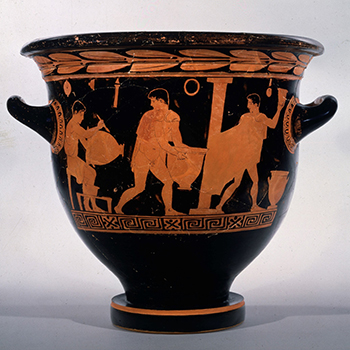Assortative Mixing in the Social Networks of Athenian Potters and the Search for Communities of Practice
DOI:
https://doi.org/10.25517/jhnr.v8i1.200Keywords:
Social networks, crafts, potters, vase-painting, ceramics, assortative, collaboration, Athens, ancient GreeceAbstract
As co-directors of the Social Networks of Athenian Potters (SNAP) project from 2017-2021, we have experimented with social network analysis to map the networks of painters and potters in Archaic and Classical Athens dating between 600−400 BCE (snap.sbs.arizona.edu). We use sociograms to visualize connections between the artists and SNA metrics to understand individuals’ roles in network terms, find clusters within the components, and then learn more about the topology and characteristics of the network as a whole. The data is derived from catalogues of vase painters who worked in the Kerameikos of ancient Athens, using the techniques called black-figure and red-figure. We have previously published the black-figure elsewhere; here we are concerned with the non-directed bimodal red-figure network composed of 13 components with 1,067 nodes and 1,583 edges. Most of the sociogram shows disassortative mixing, but we have identified one area which appears to be assortative and which we believe draws as close as possible to being representative of a social network of a community of contemporary craftsmen, to the extent our data
allows. This group of 70 artists with 94 ties between them is unusual in terms of its topological structure. The rest of the red-figure network appears to be disassortative, with high degree nodes in the center of a cluster and low degree affiliates. These hubs rarely link directly to other hubs in one degree. This network structure may reflect the master artist and his relationships with minor artists, though it could also simply visualize shapes of vases and the many artists working on that shape; it is also possible that it just reflects the bias of our source, i.e., Beazley’s published volumes. Limitations of applying SNA to material from 2,500 years ago emerge. Many historical SNA projects also have such problems and limitations, so here we present the challenges involved with working with incomplete data sets and how we chose to manage them. The decisions and choices that we made are presented here knowing that others may have addressed the problems differently and so we welcome further discussions.

Downloads
Published
How to Cite
Issue
Section
License
Copyright (c) 2023 Diane Harris Cline, Eleni Hasaki

This work is licensed under a Creative Commons Attribution-NoDerivatives 4.0 International License.
A Creative Commons Attribution-NoDerivatives 4.0 (CC BY-ND 4.0) license applies to all contents published in JHNR. While articles published on JHNR can be copied by anyone for noncommercial purposes if proper credit is given, all materials are published under an open-access license with authors retaining full and permanent ownership of their work. For details please consult the Open Access and Copyright Notice.

